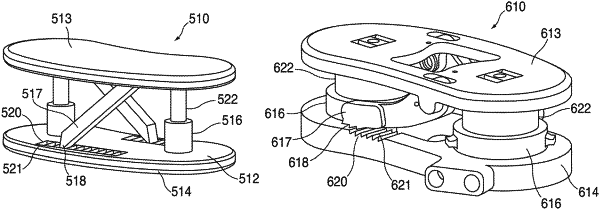| CPC A61F 2/4465 (2013.01) [A61F 2/441 (2013.01); A61F 2/442 (2013.01); A61F 2/4455 (2013.01); A61F 2002/30079 (2013.01); A61F 2002/3008 (2013.01); A61F 2002/30133 (2013.01); A61F 2002/30365 (2013.01); A61F 2002/30405 (2013.01); A61F 2002/30476 (2013.01); A61F 2002/30484 (2013.01); A61F 2002/30495 (2013.01); A61F 2002/30505 (2013.01); A61F 2002/30514 (2013.01); A61F 2002/30522 (2013.01); A61F 2002/30525 (2013.01); A61F 2002/3055 (2013.01); A61F 2002/30556 (2013.01); A61F 2002/30565 (2013.01); A61F 2002/30579 (2013.01); A61F 2002/30581 (2013.01); A61F 2002/30589 (2013.01); A61F 2002/30601 (2013.01); A61F 2/30742 (2013.01); A61F 2002/30841 (2013.01); A61F 2/4611 (2013.01); A61F 2/48 (2021.08); A61F 2/482 (2021.08); A61F 2/484 (2021.08); A61F 2310/00017 (2013.01); A61F 2310/00023 (2013.01)] | 20 Claims |

|
1. A device for stabilizing a spine of a patient's body, comprising:
an expandable fusion implant adapted to be implanted into an intervertebral space between a first vertebra and a second vertebra of the spine, the implant including a first vertebral engagement surface adapted to engage the first vertebra and an opposing second vertebral engagement surface adapted to engage the second vertebra, the implant being expandable by moving the first vertebral engagement surface away from the second vertebral engagement surface in a superior/inferior dimension such that the height of the implant is increased;
wherein, during expansion of the implant, a member of the implant advances in a first direction along a ratcheting surface that is elongated along a lateral dimension of the implant, the lateral dimension being oriented orthogonally to the superior/inferior dimension, the ratcheting surface permitting movement of the member along the lateral dimension in the first direction while resisting movement of the member along the lateral dimension in a second direction opposite to the first direction.
|